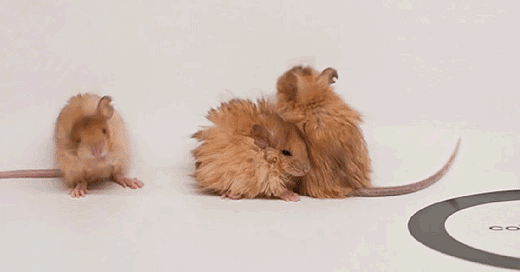Mammoth Mice
I would like to call them "micetodons," even if not technically correct
There’s more to these woolly mice than meets the eye. Sure, they are all kids of cute and so fluffy, but beyond that they also represent a scientific achievement. These floccose friends are the result of bio engineering by Colossal Biosciences, who have genetically modified the rodents to develop thick coats. The team successfully carried out a series of gene editing techniques, with one technique allowing them to make as many as eight edits in seven different genes at the same time. This project is a test of their concept to eventually modify an Asian elephant in order to “de-extinct” a woolly mammoth through gene manipulation; or more precisely, to change a modern elephant’s DNA to have some of the traits of the prehistoric pachyderm.
In the research, not yet peer-reviewed, a team used genome editing techniques to either genetically modify fertilized mouse eggs or to change embryonic mouse stem cells which were then injected into mouse embryos and implanted into surrogates. The modifications included changes to nine specific genes associated with hair traits: those that govern color, length, texture pattern and hair follicles. Two of the genes targeted in the mice are also found in the genome of mammoths, thought to have contributed to the woolly coat and golden coloration, designed to make them more “mammoth-y.” The team also disrupted a gene associated with the way fats are metabolized, suggesting a role in cold adaptation that would have been a necessary trait for ice-age mammoths. The team hopes to conduct cold tolerance tests on their modified mice in the coming months.
While the technical accomplishments of the work are certainly notable, other scientists question the the objectives of mammoth-making. Robin Lovell-Badge, head of stem cell biology and developmental genetics at the Francis Crick Institute in London, cautions that attempting to re-create a species is more complex than genetic modification, with such factors as behaviors and physiology also a consideration as to whether or not such experiments could ultimately be considered successful. Further, he questions the use of resources on a project where efforts might be better focused on saving an endangered species. Dr Tori Herridge of the University of Sheffield, is skeptical that the Colossal Biosciences team will reach their goal, stating that “Engineering a mammoth-like elephant presents a far greater challenge: the actual number of genes likely to be involved is far higher, the genes are less well understood – and still need to be identified – and the surrogate will be an animal that is not normally experimented upon.”
While Colossal Biosciences has set a goal of 2028 to deliver their first modified elephant calf, it seems unlikely that we’ll be visiting a Jurassic Park stocked with roaming mammoths any time soon, if ever. What we do have is a step forward in gene modification, with the proof of concept bringing us fluffy rodents that can possibly withstand cold temperatures. Such are the small steps in the mice-odological progress of science.
Video from here.





While the squee factor of fluffy mice is tremendous, I also question the ultimate purpose of these experiments. I love elephants and therefore find the idea of mammoths cool, there is a lot of time and money going into something that leads to what? Mammoth rides at the zoo? Of course, I could be wrong but protecting the species that haven't died out is pretty important and certainly worth the effort. But hey, they are fluffy mice! Thanks, Martini for the learning and squee factors.
Floccose.
I try to learn a new word every day. Thanks Martini!